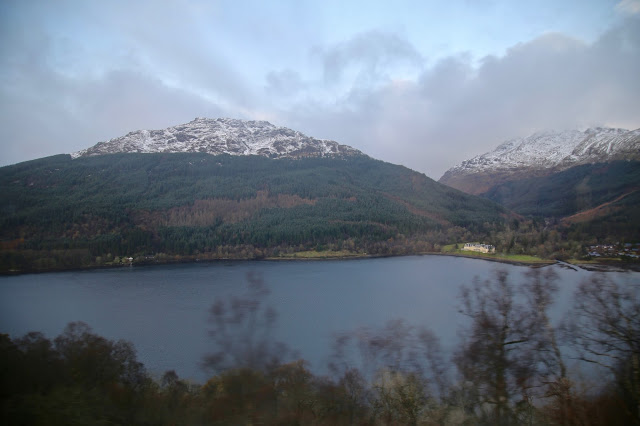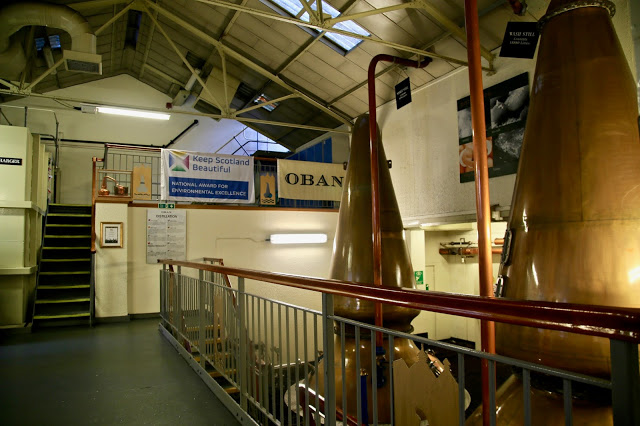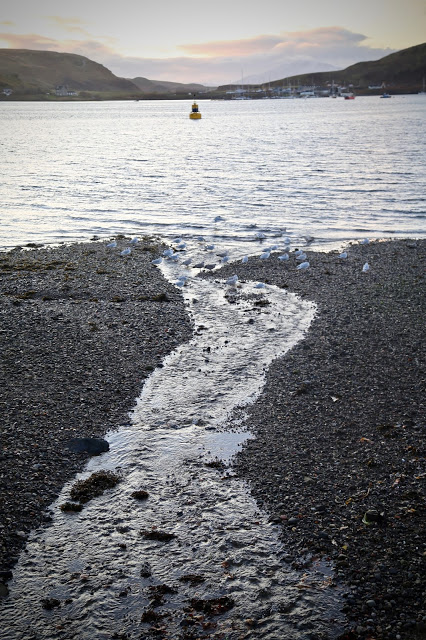



I got the early train from Glasgow to Oban: the West Highland line is one of the world’s most beautiful train rides. The weather changed every five minutes, from sunny to snowing, from rain to blue skies. You gallop past valleys, rivers, lakes, streams, lochs, snow-tipped mountains, ancient mounds, heathery hills and deer- an untouched prehistoric landscape. The other passengers, a comfort of ladies in cardigans and scarves, in lilac and raspberry, order tea and shortbread from the all important trolley.




What to do, see and eat in Oban
Oban itself is solid looking, carved out of a granite hillside under putty clouds and charcoal scrubbed sky. There is a stream over which small hump-backed bridges traverse. Basic facts about Oban that you should know:
- It has one of the best fish n chip shops in Britain called, imaginatively, ‘Oban Fish and Chip Shop’, bigged up by Rick Stein.
- The ‘Spoons overlooking the front has real log fires, but also visit other characterful pubs such as the Oban Inn. People are very friendly.
- It has a ferry port and ferries, manned by burly seamen with sexy accents, dawdling off to a selection of misty islands. These ferries are called ‘Calmac’. The islanders completely depend on Caledonian Macbrayn ferries and have a love/hate relationship with them. If you are lucky you see whales. The food is very good on the boats: they make an effort to have healthy and vegetarian options but they also have proper rib-sticking food like custard and chips. Calmac even has a whisky tour by ferry.
- I enjoyed a blustery sea walk leading to a Dunstaffnage castle, which imprisoned Flora Macdonald, but was shut by the time I got there, just before 4pm. You pass large seafront hotels with grand breakfast rooms and sea-facing rooms. People walk their tartan-coated dogs. There is a mini lighthouse and a war memorial – the section listing names beginning with the letter ‘m’ is the longest.
- The sunset in winter starts early: hazy and orange, settling into little pools in the distance, the water surface like snake skin.
- Visit the tartan shops; excellent places to get a kilt measured up, find out your tartan or your clan. You inherit your clan from your mother’s side.
- In the summer you can go on boat trips to see seals.
- It has an excellent seafood stall ‘Oban Seafood Hut’ (see this review by Jay Rayner) on the front, which is only open in summer.
- Upstairs is the equally delicious but slightly more expensive, Ee-Usk restaurant, also mentioned by Mr Rayner.
- Tour the Oban whisky distillery.
In short, Oban has everything anybody could possibly want in a town.

Visiting the Oban distillery
I visited the Oban whisky distillery and the first thing I learnt was that I wasn’t allowed to take pictures or my phone. Any electronic goods could cause a spark and blow up the distillery. You need a special license to take photographs. The picture above of the copper stills had to be taken from the doorway.
There are two broad categories of whisky: single and blends. Just as French wines do not have the grape on the front of the bottle, for the skill is in the blending of different grapes, most whisky is a blend. Although single grain whiskies, particularly single malts, are fashionable, one could also say that the skill of whisky is in the blending.
Whisky, from the Gaelic uisge or water, is a man’s drink. Very few women order it. The women’s equivalent is Baileys made with Irish whiskey. (Scottish whisky is without an ‘e’). Here is a story from the man that invented Baileys, David Gluckman. I love Baileys. In fact my whole family lived on it this Christmas, having got a duty-free deal at the airport. We didn’t get on very well this holiday, probably the only thing holding us together as a family was a daily coffee with Baileys replacing the milk. Divine! Don’t mock it till you’ve tried it.
The process
Whisky can only be called Scotch if it has been aged for at least three years. It’s usually made from barley, a grain that grows well in cold damp climates. Scotch has only three ingredients: grain, water and yeast. Soft Scottish water is what makes it unique. Additional flavour is added by smoke from peat and storage in bourbon or sherry barrels. When tasting whisky, first you ‘nose’ it. Although the ingredients are simple, flavours include orange, honey, butterscotch, salt, vanilla.
The grain or malt is dried with heat, often using peat as fuel, which adds its own flavour and smoke. Peat which covers much of the Scottish highlands, consists of thousands of years of rotted vegetation. While Oban has only a hint of peat, Lagavullin and Laphroaig have a higher percentage – as much as 65 particles per millilitre while smoke is counted in parts per million.
The process is complicated, involving: soaking the grain, ‘turning’ it on the malting floor so that it can germinate, milling in steel rollers, grist, mash, hot water, tuns and fermentation. We walk through the different rooms, each with its own overwhelming odour, either of yeast or malt or alcohol. One room contains the heart of the operation, the copper stills, the worm and something called the ‘spirit safe’ which is padlocked. Security seems to be essential. Not a drop must escape. In fact the only free booze enjoyed by locals is the fumes pumped out from the warehouse, built into the cliff face. “The neighbours are very relaxed” says our guide.
Maturing the whisky
No distillery keeps all of their whisky in the same place, it’s distributed around other distilleries in Scotland. This way they aren’t keeping all their eggs in one basket.
Whisky isn’t aged in the bottle, but in the cask. Before the 1930s, whisky had a different taste as ale, sherry or port wine barrels were used. During prohibition in the USA, white oak ex-bourbon casks were shipped to Scotland (American coopers still needed to earn a living). Today, a finishing cask using European red oak can be used, to give a richer, rounder, sweeter flavour.
The staves are flat-packed and shipped from America and put back together by coopers in Fife. The barrels are held together without ends and metal straps. There are no nails or glue. The casks are porous: 2% is lost over a year to evaporation, which is 28% over the 14 years Oban is matured. (This is why the spirit tax is paid at the end.) The casks breathe in and take on flavours such as oak and bourbon and honey.
Whisky must be stored in oak for at least 3 years and 1 day. At the same time it’s important not to leave the whisky for too long in oak.
I was surprised to learn that cask strength whisky is distilled to 70 or 80% proof and is diluted with de-ionised water to 40%. Master distillers sample all day every day but don’t get drunk. Skills.
Buying whisky
At the end of the tour we tasted Oban whisky and a couple of others. I realised that I like whisky very much, particularly peaty, smoky whisky, even though most girls don’t drink it.
Since the visit I’ve read Rachel McCormack’s entertaining book ‘Chasing the Dram’ which is her story of getting to know her own national drink. I’m currently reading Thad Vogler’s ‘By the smoke and the smell’ which has chapters on Scotch whisky, while he travels with his stepfather.
Things to look out for:
- If there is a number of years listed on the bottle, this is the age of the youngest whisky if it’s a blend.
- Connoisseurs aren’t big fans of something called ‘chill filtering’ which all the big brands do. It filters out any cloudiness but also makes whisky blander and more samey.
- This is an increasing problem as, like you find in Bordeaux, most of the brands of whisky have been bought out by large corporations.
- Scotland has 150 whisky distilleries, only six of which are independent.
- Oban claims to use its own locally grown malt. But many whisky distillers use centrally fermented malt or grain provided by the large corporation. Again this diminishes character and regionality.
How to drink it?
There is a big debate as to whether to add water. Even a couple of drops of water can ‘open’ up and sweeten the whisky. You could use a pipette to administer the water for precision.
It’s fine to have it on the rocks, with ice.
Rachel McCormack says there isn’t much tradition of using whisky in food. However it matches well with ginger and scallops and a drop of 14 year old whisky in your porridge does wonders. Whisky is quite good with curry – Johnny Walker is India’s national drink.
But I’ve got a whole new way of judging alcohol: not by the taste nor quality, not by how it’s brewed or by how old it is – none of that usual stuff. I now judge alcohol by the way it makes you feel- the particular level and variety of drunkenness which it gets you to.
Whisky gets you a nice kind of drunk. You feel mellow and chilled out. You don’t get angry or randy or violent. You just feel relaxed and blissed out and not-give-a-shittish.
This is a parameter that is so often forgotten.










A very interesting account of what looks like a beautiful place. My parents both drink whisky (note, actual whisky, not whiskey or bourbon) every evening, and prefer the non peaty type. I got to appreciate the drink when I organised a tasting session for my previous job. Since then, I love to discover new types… usually go for single malt, but my latest choice (for them, I only sniff it!) is Hibiki Harmony Blend.
Is that Japanese whisky? I'm about to start reading Dave Broome's book on Japanese whisky.